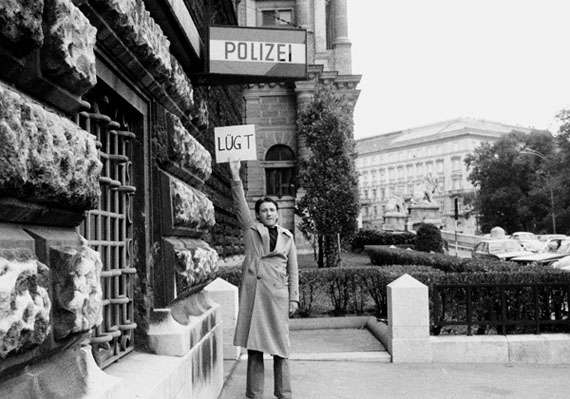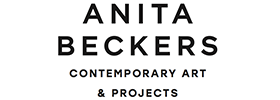
Photo: Archive Peter Weibel © Peter Weibel
Peter Weibel »
Political Performance
Politische Performance
Exhibition: 6 Jun – 24 Aug 2013
Wed 5 Jun 19:30

Galerie Anita Beckers
Braubachstr. 9
60311 Frankfurt (Main)
+49 (0)69-92101972
info@galerie-beckers.de
www.galerie-beckers.de
Tue-Fri 11-18, Sat 12-17

Peter Weibel
Politische Performance
Exhibition: June 6 – August 24, 2013
Opening: Wednesday June 5, 7:30 pm
Through the advances of Fine and Performing Arts in the 1960s, a new art form was created: performance. The sources of the performance were mostly painting, sculpture, music and dance. Since 1964, Peter Weibel (*1944 Odessa) has pioneered an influential and exceptional pathway, namely 1. to transform language and media into fields of action 2. to emphasize the participation of the audience. Instead of underlying the monarchist tradition of the artist's presence, he democratically focused on the audience. He recognized the political as the decisive field of action and thus developed an own sense of political performance, which anticipated the activism of the 21st century.
The exhibition »Political Performance« shows major works of the 1960s and 1970s as well as selected recent works by the artist Peter Weibel. From the 1960s onwards, artists have increasingly left the safe space of institutions and expressed themselves - criticizing them at the same time – through ephemeral events such as performances, happenings and actions. Usually, the relics of such actions are exhibited in display cases in a skillful manner in order to win a certain sculptural character. Photographic documents are oversize enlarged and printed on canvas to bring back a picturesque character. For Peter Weibel however, the action as a process is the artwork and the process is not converted back into an object. Therefore, the artifacts refer to their documentary character, unless it is media art originally.
In many cases, performance art of the 20th century devoted itself solely to self representation of the artist and his own (artistic) identity. The focus lay in the artist as a performer. On the contrary, Peter Weibel brought forth the participation and interaction of the audience. In the spirit of a democratic promise he turned not only to an audience in the gallery or theater space, which had already entered art institution, but to the audience on the street as the legendary »Tapp- und Tastkino« (1968, Munich) or at the action from the Aktion Aus der Mappe der Hundigkeit (1969, Vienna) together with Valie Export, to the audience in the auditorium of the university, as »Kunst und Revolution« (1968, Vienna) with the Viennese Action Group or to the television audience. Peter Weibel thus recognized the role of mass media in the construction of our reality and opened it as a field of action.
His work remained political: In view of the current debate about globalization, financial crisis and capitalism, many of his works from the 1960s to the 1980s appear almost prophetic, like the work from 1984 titled »Sculpture in Public Space«, in which a space shuttle crashes into a skyscraper. Fire appears repeatedly as a motif, suggesting not only what was already then perceived as an urgent problem, but also in the context of activist, revolutionary and terrorist actions. With the convergence of political and artistic action Peter Weibel anticipated the artistic activism of the 21st century. This is testified by complex blocks of themes on the constitutional state, the welfare state, terrorism and revolution.�

Peter Weibel
Politische Performance
Ausstellung: 6. Juni bis 24. August 2013
Eröffnung: Mittwoch 5. Juni, 19:30 Uhr
In den 1960er-Jahren entstand durch Weiterentwicklungen der bildenden und darstellenden Künste eine neue Kunstform: die Performance. Die Quellen der Performance waren meistens Malerei, Skulptur, Musik und Tanz. Peter Weibel (*1944 in Odessa) hat ab 1964 einen einflussreichen Sonderweg gebahnt, nämlich 1. Sprache und Medien in Handlungsfelder zu verwandeln und 2. die Partizipation des Publikums zu betonen. Statt der monarchistischen Tradition der Präsenz des Künstlers stellte er als demokratisches Versprechen das Publikum in den Mittelpunkt. Er erkannte das Politische als entscheidendes Handlungsfeld und entwickelte so eine eigene Richtung der politischen Performance, welche den Aktivismus des 21. Jahrhunderts antizipierte.
Die Ausstellung Politische Performance zeigt Hauptwerke aus den 1960er- und 1970er-Jahren sowie ausgewählte neuere Arbeiten des Künstlers. Ab den 1960er-Jahren verließen die Künstler zunehmend die sicheren Räume der Institutionen und drückten sich – diese zugleich kritisierend – in ephemeren Ereignissen wie Performances, Happenings und Aktionen aus. Normalerweise werden die Relikte solcher Aktionen auf geschickte Weise in Vitrinen ausgestellt, um den skulpturalen Charakter zurückzugewinnen. Fotografische Dokumente werden überdimensional vergrößert und auf Leinwand gedruckt, um den malerischen Charakter wieder herzustellen. Für Peter Weibel allerdings bleibt die Aktion als Prozess das Kunstwerk und der Prozess wird in kein Objekt zurückverwandelt. Daher verweisen die Exponate auf ihren dokumentarischen Charakter, es sei denn, es handelt sich von vornherein um Medienkunstwerke.
In vielen Fällen war die Performance-Kunst des 20. Jahrhunderts allerdings nur der Selbstdarstellung des Künstlers bzw. der Künstlerin und der eigenen (künstlerischen) Identität gewidmet. Im Mittelpunkt stand der Künstler als Performer. Peter Weibel stellte dem gegenüber die Partizipation und die Interaktion des Publikums in den Vordergrund. Im Sinne eines demokratischen Versprechens wandte er sich dabei nicht nur an ein Publikum im Galerie- oder Theaterraum, das bereits in eine Kunstinstitution eingetreten war, sondern an das Publikum auf der offenen Straße. Legendär sind »Tapp- und Tastkino« (1968, München) oder die »Aktion Aus der Mappe der Hundigkeit« (1969, Wien) gemeinsam mit Valie Export sowie »Kunst und Revolution« (1968, Wien) mit den Wiener Aktionisten. Peter Weibel erkannte dabei die Rolle der Massenmedien in der Konstruktion unserer Wirklichkeit und machte sie als Handlungsfeld fruchtbar.
Seine Arbeiten sind immer politisch: Im Hinblick auf die gegenwärtige Diskussionen um Globalisierung, Finanzkrise und Kapitalismus erscheinen viele seiner Werke aus den 1960er- bis 1980er-Jahren fast prophetisch, etwa eine Arbeit aus dem Jahre 1984 mit dem Titel Skulptur im öffentlichen Raum, bei dem ein Spaceshuttle in einen Wolkenkratzer kracht. Immer wieder erscheint Feuer als Motiv, das nicht nur auf schon damals empfundene Dringlichkeit der Probleme hindeutet, sondern immer auch im Kontext aktivistischen, revolutionären und terroristischen Handelns auftaucht. Mit der Konvergenz von politischer und künstlerischer Aktion antizipierte Peter Weibel den künstlerischen Aktivismus des 21. Jahrhunderts. Davon zeugen Themenkomplexe zur Rechts- und Sozialstaatlichkeit, zum Terrorismus und zur Revolution.
